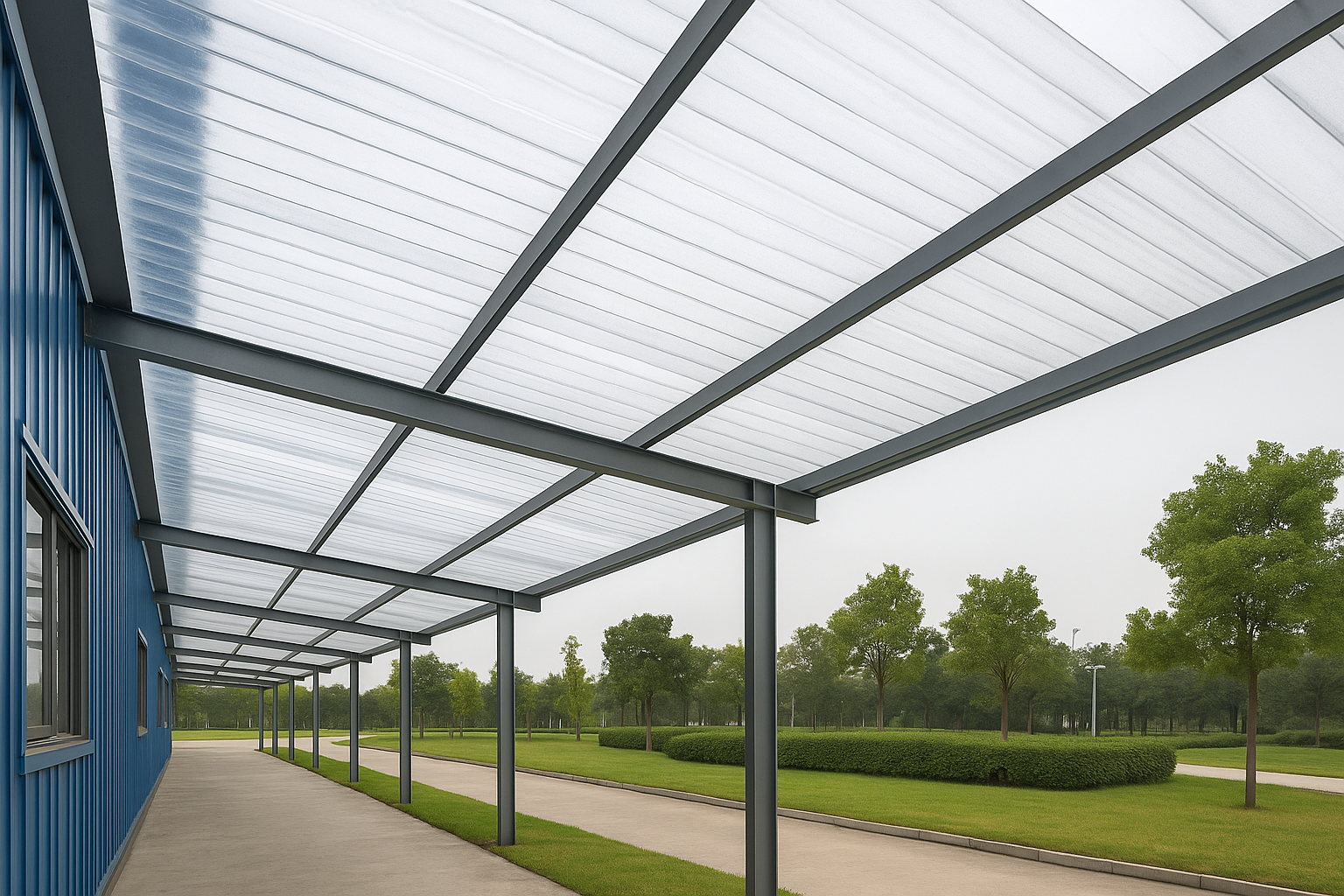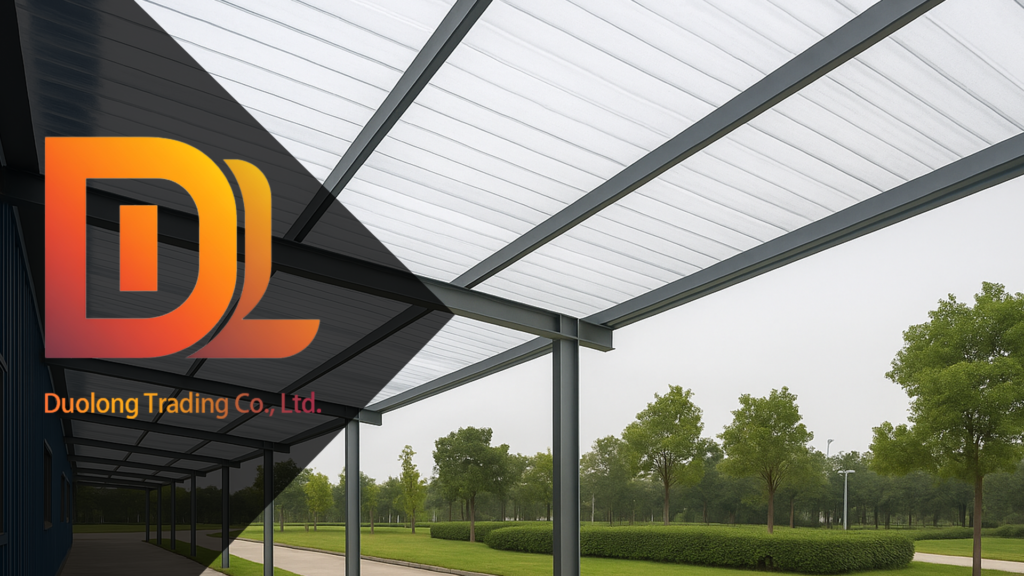As natural lighting becomes an essential requirement in industrial plants, greenhouses, storefront roofs, and public market walkways, the demand for high-performance daylighting panels is rising across the construction sector. Traditional options like glass and acrylic boards are increasingly challenged by durability limitations, safety risks, and installation constraints.
This shift has led to the growing prominence of FRP (Fiberglass Reinforced Plastic) transparent roofing sheets. Offering a lightweight structure, excellent weather resistance, and high light transmission, FRP has emerged as a preferred solution for builders and project planners seeking efficiency and long-term reliability.
What Is FRP Transparent Roofing Sheet?
FRP stands for Fiberglass Reinforced Polymer, a modern composite material made by combining glass fiber with polyester resin. This combination gives FRP its signature strength, flexibility, and transparency—ideal features for roofing materials designed to allow natural light in while withstanding harsh weather.
The structure of an FRP daylighting sheet typically includes a translucent surface embedded with reinforcing glass fibers, which give it added durability without sacrificing light transmission. It’s not brittle like glass and doesn’t yellow easily like some plastics.
Visually, FRP sheets often appear semi-transparent with a frosted or corrugated texture. They come in various wave patterns such as sinusoidal, trapezoidal, or flat forms, and are available in standard widths like 840mm, 900mm, and 1000mm. Common colors include clear white, light blue, green, and milky white, allowing clients to choose based on both function and aesthetics.

Key Advantages of FRP Transparent Roofing Sheets
FRP (Fiber Reinforced Polymer) transparent roofing sheets are gaining popularity due to their balanced performance in strength, light transmission, and durability. Here are the core advantages that make them ideal for modern roofing needs:
- Weather Resistance: FRP panels are designed to resist UV radiation and prevent yellowing over time, making them suitable for long-term outdoor exposure.
- High Strength: The composite structure provides excellent impact resistance and crack prevention. Unlike brittle materials, FRP sheets are not prone to sudden breakage.
- Balanced Light Transmission: FRP sheets allow soft, diffused natural light to pass through, creating a bright yet glare-free environment inside. This reduces eye strain in workspaces and helps save on artificial lighting.
- Lightweight & Easy Installation: The sheets are lightweight and require less structural support, which lowers installation costs and labor demands.
- Corrosion Resistance: Ideal for environments with acid rain, salt spray, or chemicals. FRP remains stable where metal or glass might degrade.
- Low Maintenance & Long Service Life: FRP panels require minimal upkeep and can typically last 10 to 15 years, depending on usage conditions.
Application Scenarios: Where Are FRP Transparent Roofing Sheets Best Used?
FRP transparent roofing sheets offer a versatile solution for natural lighting across different building types. Their adaptability to harsh environments, combined with lightweight structure and good light diffusion, make them ideal for the following scenarios:
- Industrial Plants: Ideal for strip skylights along workshop roofs, allowing uniform daylight to penetrate large production areas without compromising structural integrity.
- Greenhouses/Nurseries: FRP panels help maintain stable temperatures and filtered lighting, providing optimal growing conditions for plants.
- Commercial Buildings: Perfect for roofing in farmers’ markets, warehouse centers, and parking structures where lighting and weather resistance are both needed.
- Walkways and Awnings: Commonly used in public passageways, outdoor canopies, or semi-open areas to provide natural light while offering protection from rain.

Comparison: FRP Skylight Panels vs. Other Common Transparent Roofing Materials
In today’s roofing market, there are several popular materials used for skylight applications, including FRP panels, traditional glass, PC (polycarbonate) sheets, and PVC transparent tiles. Each of these has distinct characteristics in terms of durability, cost, safety, and light transmission.
From a cost-efficiency standpoint, FRP panels strike a practical balance. They are significantly more affordable than traditional glass and PC sheets, yet offer superior mechanical strength compared to PVC tiles. When it comes to light transmission, FRP allows for soft, diffused daylight that reduces glare, making it ideal for both human comfort and indoor plant environments.
In terms of impact resistance, FRP outperforms both glass and most PVC products. It resists cracks, breakage, and splinters under external force—making it safer in harsh environments or during accidental impacts. Moreover, the ease of cutting and installation gives FRP a construction advantage, especially for large-scale factory roofs or retrofit projects where efficiency matters.
Compared with “non-glass” transparent options, FRP ranks highest in overall performance. While polycarbonate sheets may offer higher clarity, they often come at a significantly higher cost and lower lifespan in acidic or humid climates. Therefore, FRP remains the most balanced solution for projects that demand safety, light control, and cost containment.
Purchasing Advice and Specification Reminders
When choosing FRP daylighting sheets, it’s important to match the product to your project’s functional needs. For instance, industrial warehouses may require thicker sheets with lower light transmittance to minimize glare, while greenhouses may benefit from higher transparency to optimize plant growth. Additionally, color choices can influence both aesthetics and heat absorption.
Buyers should also pay attention to critical quality factors such as anti-counterfeit labeling, fire-resistance rating (e.g., B1, B2 standards), and whether the product meets national or international certifications such as ISO or ASTM. These certifications are essential indicators of performance reliability.
Another key consideration is the supply chain source. FRP sheets from direct factory supply typically offer better batch consistency, thickness accuracy, and long-term performance stability compared to market-assembled options that may vary in quality. Stable sourcing means fewer issues in large-scale applications and less variability in installation quality.
How FRP Transparent Sheets Enhance Project Efficiency
FRP transparent roofing sheets offer a comprehensive set of advantages that make them a strategic material choice in modern construction. Their ability to reduce long-term energy consumption, minimize maintenance demands, and deliver reliable performance over 10–15 years makes them an optimal solution for projects seeking long-lasting efficiency.
As contractors and developers aim to improve cost control and durability, FRP emerges as a material that balances function, safety, and economy. Its resistance to UV, chemicals, and impact—combined with customizable light transmission—ensures practical value beyond just aesthetics.
Therefore, we strongly encourage purchasers, project managers, and government contractors to consider FRP transparent sheets as part of their standard building material catalogs. Integrating FRP into roofing design is not just a material upgrade—it’s a forward-thinking investment in energy-saving, cost-efficient, and sustainable architecture.


